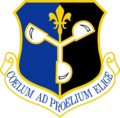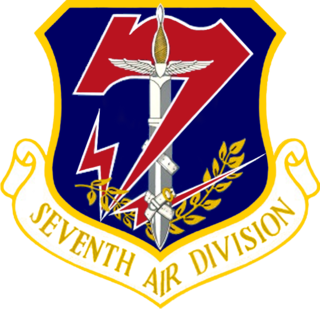
The 7th Air Division served the United States Air Force with distinction from early 1944 through early 1992, earning an outstanding unit decoration and a service streamer along the way.

The 58th Reconnaissance Squadron is an inactive United States Air Force squadron. Its last was assigned to the 9th Weather Reconnaissance Wing at Kirtland Air Force Base, New Mexico, where it was inactivated in 1974.

The 15th Special Operations Squadron is part of the 1st Special Operations Wing at Hurlburt Field, Florida. It operates Lockheed MC-130J Commando II aircraft in support of special operations.

The United States Air Force's 9th Combat Operations Squadron is an Air Force Reserve Command space operations unit located at Vandenberg Space Force Base, California. The 9th augments the 614th Air and Space Operations Center in operating the Joint Space Operations Center, performing combat operations, plans, strategy and intelligence assessments that enable the Commander, Joint Functional Component Command for Space to command and control space forces by providing worldwide space effects and theater support to combatant commanders.

The 358th Fighter Squadron is part of the 495th Fighter Group at Whiteman Air Force Base, Missouri. The squadron was reactivated there in 2015. The squadron was formerly part of the 355th Operations Group at Davis–Monthan Air Force Base, Arizona, operating the Fairchild Republic A-10 Thunderbolt II aircraft conducting close air support missions, until its 2014 inactivation.

The 38th Reconnaissance Squadron is a United States Air Force unit. It is a part of the 55th Wing at Offutt Air Force Base, Nebraska. It operates the Boeing RC-135 aircraft conducting reconnaissance missions.

The 343d Reconnaissance Squadron is a United States Air Force unit part of the 55th Wing at Offutt Air Force Base, Nebraska. It operates the RC-135V/W Rivet Joint aircraft conducting reconnaissance missions.

The 512th Rescue Squadron is part of the 58th Special Operations Wing based at Kirtland Air Force Base, New Mexico. It formerly operated the Bell UH-1N Twin Huey and currently operates the Sikorsky HH-60G Pave Hawk and the new HH-60W Jolly Green II helicopters training aircrew conducting search and rescue missions.
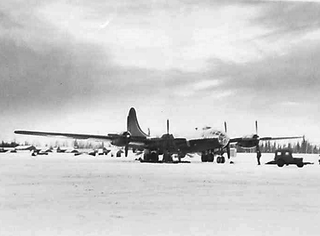
The 311th Air Division is an inactive United States Air Force organization. Its last assignment was with Strategic Air Command at Barksdale Air Force Base, Louisiana, where it was inactivated on 1 November 1949. The division was first activated in 1944 as the 311th Photographic Wing. Although it was stationed in the United States, throughout its existence, the unit was responsible for the control of long range reconnaissance units in multiple theaters.

The 57th Weather Reconnaissance Squadron is an inactive United States Air Force squadron. Its last assignment was with the 9th Weather Reconnaissance Wing at Hickam Air Force Base, Hawaii, where it was inactivated on 10 November 1969.
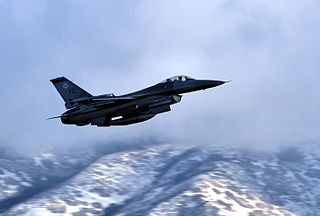
The 514th Flight Test Squadron is a squadron of the United States Air Force, which has been stationed at Hill Air Force Base, Utah since 1973, performing functional flight checks on aircraft undergoing major maintenance.

The 44th Reconnaissance Squadron is a unit of the United States Air Force's 432nd Wing, Air Combat Command stationed at Creech Air Force Base, Nevada, where it operates unmanned aerial vehicles. The squadron is assigned to the 432nd Operations Group, and has been reported to operate the Lockheed Martin RQ-170 Sentinel.

The United States Air Force's 10th Intelligence Support Squadron is an intelligence unit located at Langley Air Force Base, Virginia.

The 308th Armament Systems Group is a unit of the United States Air Force's 308th Armament Systems Wing, stationed at Eglin Air Force Base, Florida. The group was first activated at Gowen Field, Idaho as the 308th Bombardment Group. It served as a Consolidated B-24 Liberator unit in the China-Burma-India Theater, where it conducted long range bombing missions against Japanese forces, earning a Distinguished Unit Citation. Following V-J Day, it returned to the United States and was inactivated in January 1946.

The 28th Operations Group is the flying component of the United States Air Force 28th Bomb Wing, stationed at Ellsworth Air Force Base, South Dakota.

The 513th Electronic Warfare Squadron is a United States Air Force unit assigned to the 350th Spectrum Warfare Wing at Eglin Air Force Base, Florida.

The 375th Bombardment Squadron is an inactive United States Air Force unit. Its last assignment was with 308th Bombardment Wing at Plattsburgh Air Force Base, New York.

The 718th Bombardment Squadron is an inactive United States Air Force unit. It was last assigned to the 4128th Strategic Wing at Amarillo Air Force Base, Texas, where it was inactivated on 1 February 1963.

The 352d Bombardment Squadron is an inactive United States Air Force unit. It was last assigned to the 301st Bombardment Wing at Lockbourne Air Force Base, Ohio, where it was inactivated on 8 June 1964.
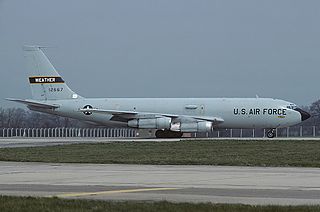
The 55th Space Weather Squadron is an inactive United States Air Force unit. It was last assigned to the 50th Operations Group at Schriever Air Force Base, Colorado, where it was inactivated on 16 July 2002.



























